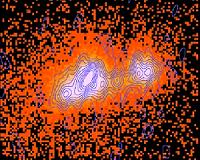 |
Washington (AFP) Jan 10, 2011 US astronomers have discovered a huge black hole, a million times the mass of the sun, in a nearby galaxy -- a finding that could help better understand the origins of the universe. The announcement Monday by the American Astronomical Society said the surprise discovery in a so-called "dwarf" galaxy offers evidence that black holes -- regions of space where not even light can escape -- formed before the buildup of galaxies. "This galaxy gives us important clues about a very early phase of galaxy evolution that has not been observed before," said Amy Reines, a researcher at the University of Virginia who presented the findings to the AAS annual meeting. The galaxy, called Henize 2-10, is 30 million light-years from Earth, has been studied for years, and is forming stars very rapidly. It resembles what scientists think were some of the first galaxies to form in the early universe. Reines along with Gregory Sivakoff and Kelsey Johnson of the University of Virginia and the National Radio Astronomy Observatory (NRAO), and Crystal Brogan of the NRAO, observed Henize 2-10 with the National Science Foundation's Very Large Array radio telescope and with the Hubble Space Telescope. They found a region near the center of the galaxy that strongly emits radio waves with characteristics of those emitted by super-fast "jets" of material spewed outward from areas close to a black hole. They then searched images from the Chandra X-Ray Observatory that showed this same, radio-bright region to be strongly emitting energetic X-rays. This combination, they said, indicates an active, black-hole-powered, galactic nucleus. "Not many dwarf galaxies are known to have massive black holes," Sivakoff said. While black holes of roughly the same mass as the one in Henize 2-10 have been found in other galaxies, those galaxies all have much more regular shapes. "This galaxy probably resembles those in the very young universe, when galaxies were just starting to form and were colliding frequently. All its properties, including the supermassive black hole, are giving us important new clues about how these black holes and galaxies formed at that time," Johnson said.
Share This Article With Planet Earth
Related Links Understanding Time and Space
 Surprise: Dwarf Galaxy Harbors Supermassive Black Hole
Surprise: Dwarf Galaxy Harbors Supermassive Black HoleHilo HI (SPX) Jan 10, 2011 The surprising discovery of a supermassive black hole in a small nearby galaxy has given astronomers a tantalizing look at how black holes and galaxies may have grown in the early history of the Universe. Finding a black hole a million times more massive than the Sun in a star-forming dwarf galaxy is a strong indication that supermassive black holes formed before the buildup of galaxies, t ... read more |
|
| The content herein, unless otherwise known to be public domain, are Copyright 1995-2010 - SpaceDaily. AFP and UPI Wire Stories are copyright Agence France-Presse and United Press International. ESA Portal Reports are copyright European Space Agency. All NASA sourced material is public domain. Additional copyrights may apply in whole or part to other bona fide parties. Advertising does not imply endorsement,agreement or approval of any opinions, statements or information provided by SpaceDaily on any Web page published or hosted by SpaceDaily. Privacy Statement |